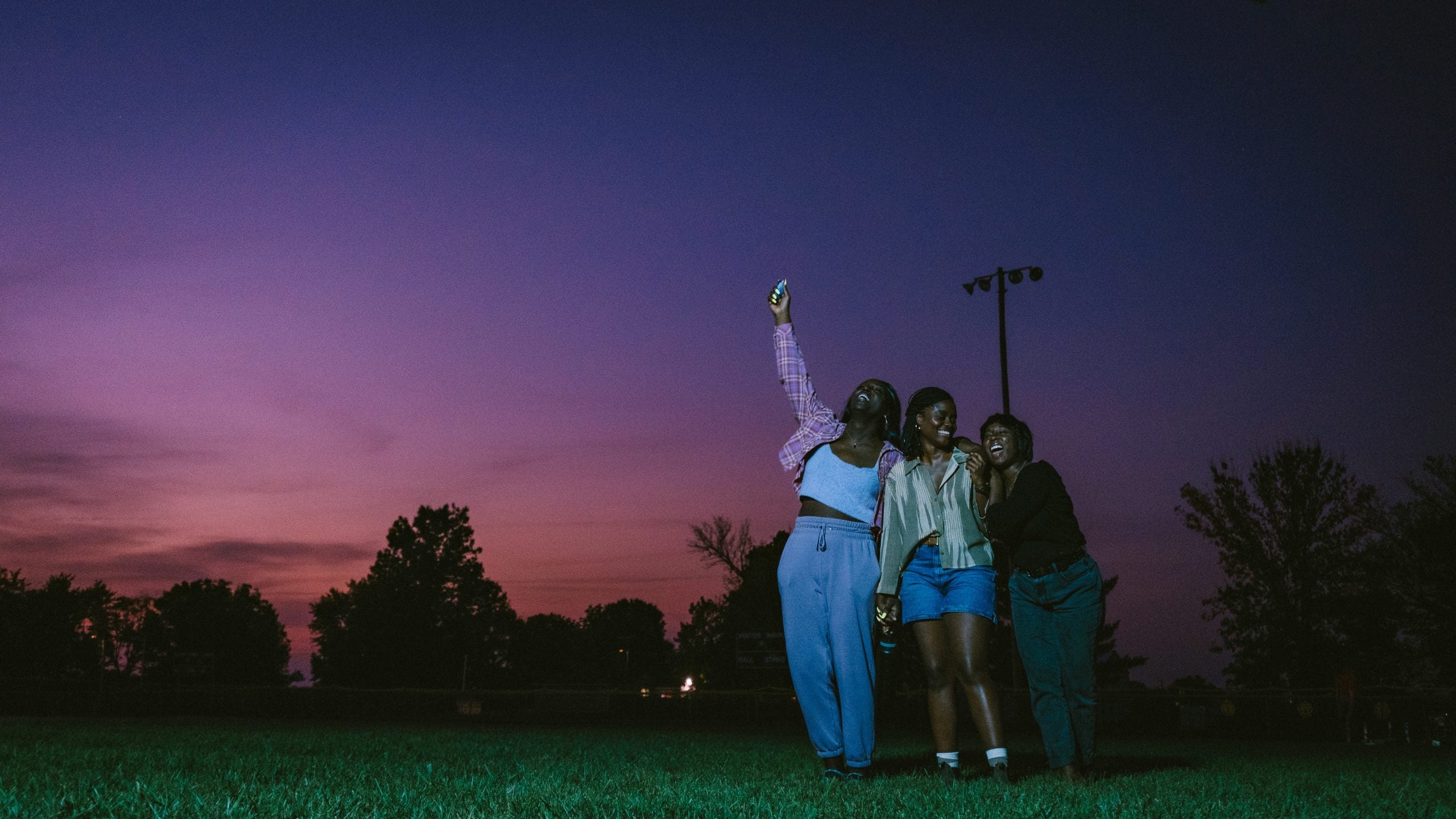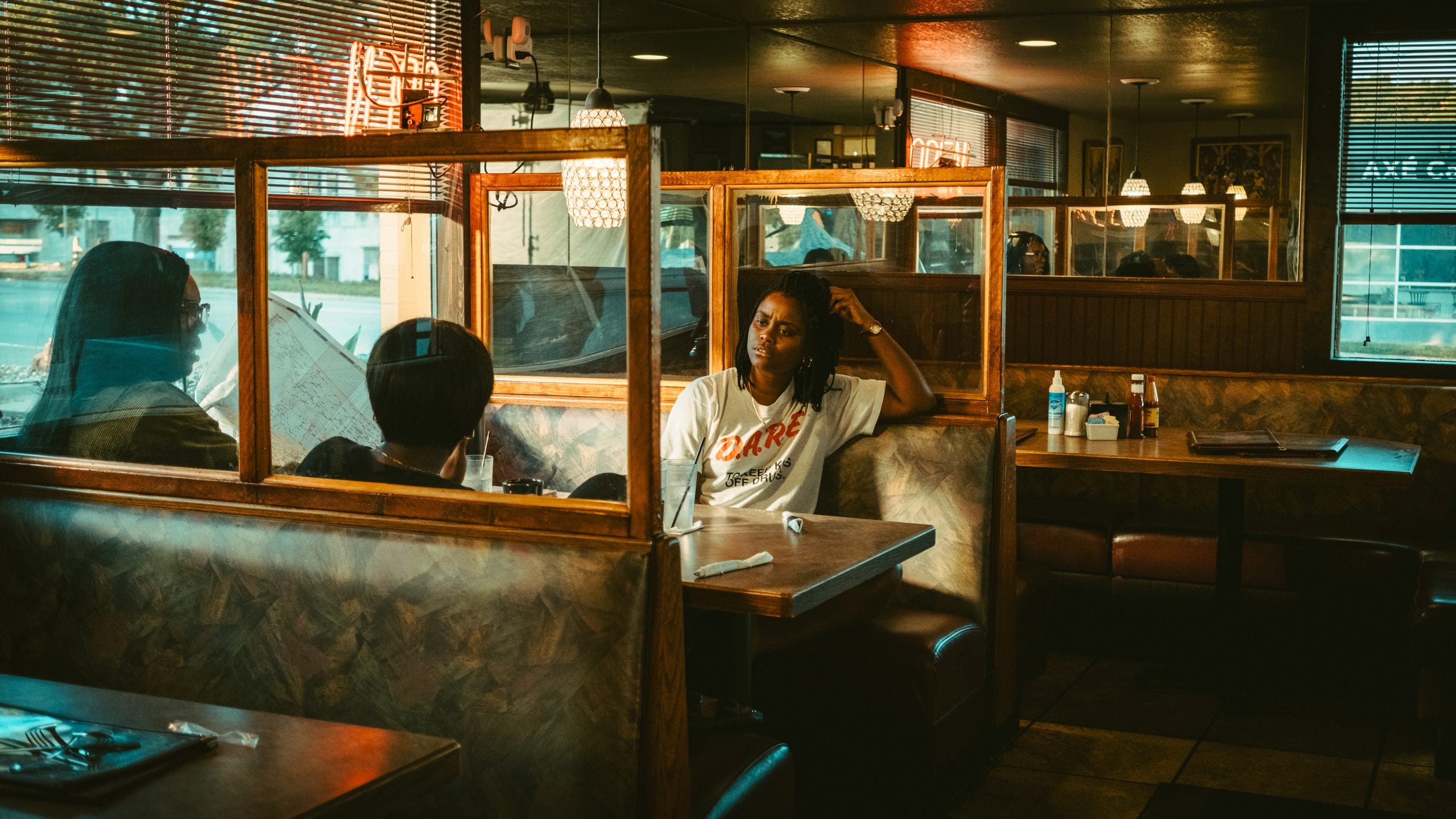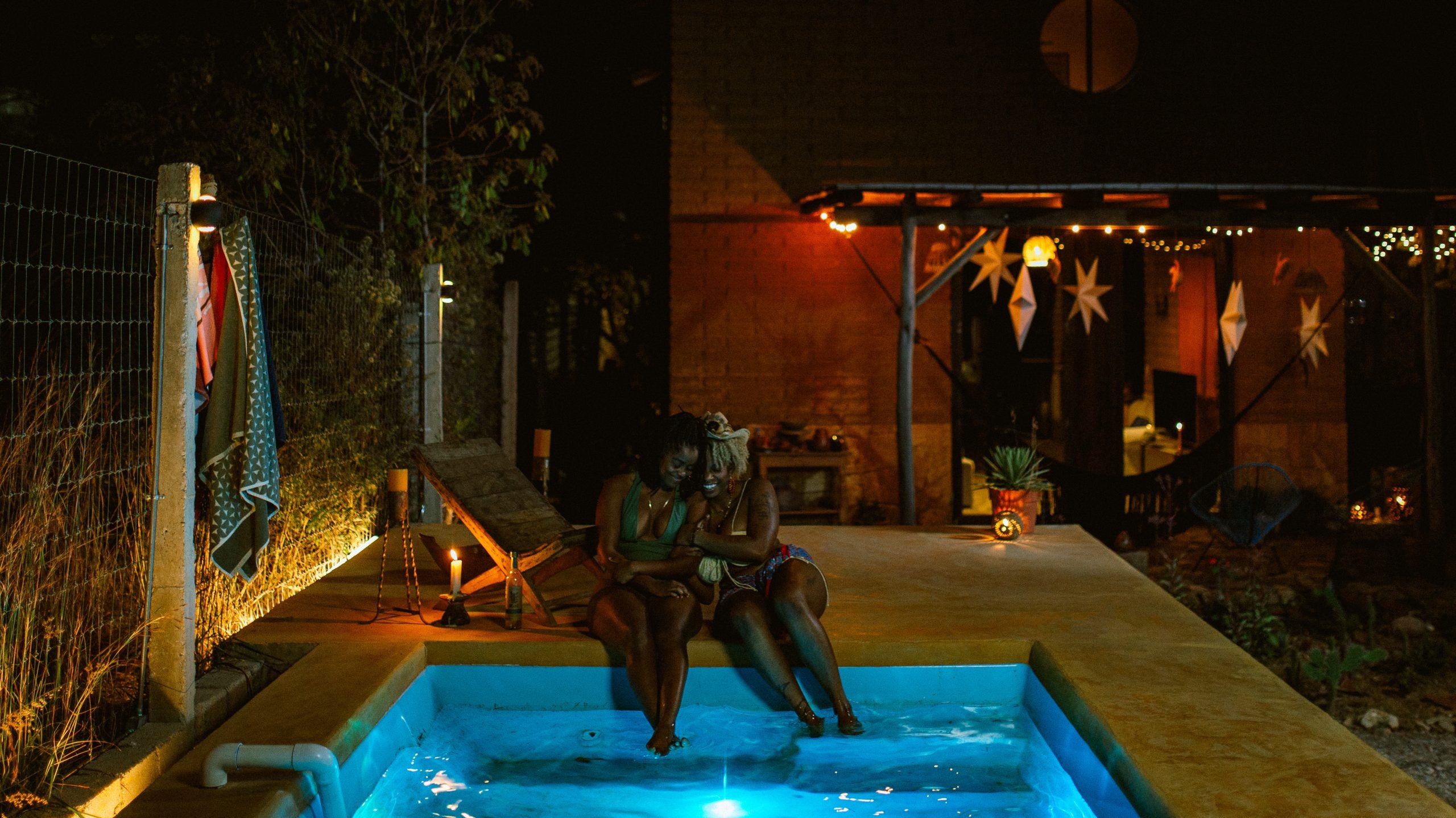For director and screenwriter Shatara Michelle Ford, real life can offer the richest kind of cinema. After garnering critical acclaim for her debut feature, Test Pattern, a 2019 film that peered through the complex and blurry layers of an isolated incident in a Black woman’s life, her highly anticipated sophomore film premieres this week at this year’s Black Star Film Festival. Serving as the premiere film for the fest, her newest offering entitled Dreams in Nightmares is a tender, thoughtful rendering of the Great American road-trip genre. The film centers on four Black queer femmes traveling through the Midwest in search of a friend who has gone off the grid.
Starring budding luminaries like the Tony Award nominee Denée Benton, Sasha Copere, Charlie Barnett, Jasmin Savoy Brown, Mars Storm Rucker, and Dezi Bing, it’s a creative venture less interested in reifying commercial aspirations. Instead, the film is more concerned with reflecting the life-affirming qualities of people perpetually erased. Working alongside costume designer, Mikhaela Zabalerio, when it came to style and aesthetics, Ford’s biggest aim was to showcase the cast as lit-from-within beautiful, bone-deep, and pure, paying little attention to artificial or binary notions of glamor and becoming. The end product is a moving film that celebrates the ever-changing moods that make us real and also human.
Ahead of the premiere of Dreams in Nightmares at this year’s Black Star Film Festival, ESSENCE spearheaded a roundtable discussion with Shatara Michelle Ford, Mikhaela Zabalerio, and Denée Benton.

Dreams in Nightmares. Photo Credit: Black Star Film Festival
ESSENCE: We are often reduced to stereotypes or someone else’s fantasy in film. Do you feel you created something radically honest with Dreams in Nightmares?
Shatara Nicole Ford: I’m forever influenced by older movies. The trends happening today in films that are situated in “real life” are almost always aspirational and fantastical. I think of the [show] Sex and the City and things of that nature–I’m just not interested. I’m more focused on how the elements of our world contribute to who we are as people. With my team for this film, especially with the visuals, I wanted to go underneath that kind of glossiness. Each of these characters has their own vivaciousness, their own brightness and aura and I wanted to highlight that radiance, to saturate their world in colors that relate to their perspectives.
A reference of mine was the film Crooklyn, which was so accurate for the period but very revealing of characters and circumstances and the world they occupied. Dreams in Nightmares for me, was about vanishing the surfeit of artifice that can be extremely limiting. I wanted to play with and reinforce standards of beauty that we have always known existed, but might not have been permissed on-screen for a million different reasons. I wanted to challenge the idea of what we are wearing on screen, of how we actually look as we sit in our living rooms with our besties. Most of those scenes today, they’re not common in commercial films. Typically, we usually try to find the hottest label, the hottest brand, even the sexiest, most-elevated bonnets for the look, and those things subconsciously feedback to us, signaling that we need to look perfect. We are beautiful as we are and I was interested in forcing us to remember that.
Mikhaela Zabalerio: This was one of the most special and rare projects I’ve had the opportunity to work on. Like Shatara said, from a style standpoint, on most of the projects I’ve worked on it’s common to get the most expensive, most decadent pieces that look the best on camera. For Dreams in Nightmares, it was important for us to scale back, to think first of the characters, their inner worlds, [and] their spirits.
The bulk of the wardrobe was thrifted, so many good finds we picked up in places you would never expect. It was our aim to make everything feel grounded, to think of the practical aspects of each garment versus thinking about what executives might want because it’s flashier. Shatara gave such a broad strokes approach and I just created with the thought: “What would these characters really wear? What would be truly authentic to their lives if the cameras weren’t on? How would these looks read in life, not just for a scene and effect.”

Denée, you’ve starred in roles that require period dressing and Broadway productions that involve incredible ensembles, can you tell me what it is like to embody this kind of radical authenticity on screen?
Denée Benton: It was very new for me and so humbling. Shatarra kept challenging all of us in the cast to truly allow ourselves to be seen. As Black femmes, with the standards of beauty that we’ve inherited from so many places that was incredibly vulnerable. The comfort level that I would have been seen by my best friend at home is not necessarily the same comfort level of comfort expected if I were to be walking down the street. I love that I can lay around the house with my girlfriends and my edges aren’t done, there’s hair fuzz on my face and arms and even though I still feel beautiful in those moments when it came time for me to show up on film, I found myself resisting.
I was like, wait can at least lay these edges down or if something wasn’t form-fitting I would say, wait, can we make it a crop top? Shatarra kept fighting that and it was beyond healing for me to remember I do deserve to have the camera sit on me this long even though you can see my sideburns and I’m not wearing my favorite bad bitch nails. For my inner child playing the role of Z challenged me to examine my own sense of worthiness and value.
Despite being informed by old Hollywood techniques, Dreams in Nightmares manages to feel modern, how did you manage this?
Shatara Nicole Ford: During the 1940s and 1950s, in periods like German expressionism and melodrama, those films were considered women’s films because they were certain on inward and emotional terrains. But the center of these films was always white women. For me, I stole a lot of the tools from those movies. Dreams in Nightmares has my protagonists lit in the most gorgeous, gleaming, oozing, dripping light–I’m pumping it on.
I used all those old Hollywood techniques, their structures in which they would soften faces, adding that dreamy, additional glow, but I’m throwing it back on us, reinforcing us and not in that way where it makes you crave anything outside of yourself. Mikhaela did such a brilliant job with the costumes and offering such diverse modes of expression, we left so much room for different versions of black femmes to exist together.
Mikhaela Zabalerio: Even in terms of the glamour, of the style, we wanted to honor different modes of what those things can mean. We didn’t rage against the beauty standards, but tried to maintain this is what life looks like in the ways of people who are given the space to exist and belong. Each of these characters [includes] all facets of Shatarra’s personality, but they have distinct color palettes.
There’s Tasha, who is bougie and loves her black, wearing color only loosely. Lauren wears her purple and green. Then there’s Z, who Denée plays, who wears earthy, natural hues. And then there’s Kel, who is a mix of everyone, a bit more bohemian. As we know, beauty comes in so many forms, through the styling we wanted to keep who they were as the focus, using clothes to show off their personalities.

How did filming change you?
Shatarra Nicole Ford: I wanted to celebrate an odyssey that is fundamentally mine, but theoretically yours, even though it may be foreign to some or others. During the height of the pandemic I did a lot of road tripping, [things were] getting real, and we all needed time to dream about other possibilities for our lives. That’s what everyone in this film is doing, asking themself: is this the life I want to be living? Am I being as true to myself as I possibly can?
The film is trying to reckon with the fact that reality is reality, life is difficult, and it doesn’t mean we don’t deserve lightness and joy. Our people have gone through so much and managed to thrive. We can still cultivate small miracles and dreams for ourselves. We can still yearn for and create greater systems of care.
Mikhaela Zabalerio: When I tell you, thrifting and finding the most incredible things in small towns like Kansas or [a] random Goodwill I stumbled across and found a focal piece in the film and freeing myself to think about what these people look like every day, it rewired my brain to insist on the living qualities of these characters, that’s such a rarity in this industry that insists on imposing standards that are not ours.
Denée Benton: The biggest thing I learned was how much more access you have to your brain’s capabilities when you feel welcomed as you are. It’s so simple, but this act of sacred belonging can change your nervous system. Dreams in Nightmares was unlike anything I’ve done and we tend to forget that our imaginations are ungovernable, there is so much space to create outside of a legislative imagination and we are tired of living inside of an imagination, that we call real, but it’s just some psychosis of whiteness and patriarchy.
To watch these black femmes figure out how to belong to each other, to belong to themselves, to get introduced to new parts of themselves, all because they belong, belong in every way it’s an important texture to the cinema being made, I hope it can create more stories and affirm more lives.
Dreams in Nightmares premieres on August 1 at the 2024 Black Star Film Festival in Philadelphia. Head to the festival’s official site for more details.







